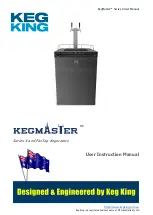
17
Positioning of graphite electrodes:
Presentation of the electrodes
Rod type electrodes
Rod electrodes are mainly used for use in boxed locations where connections are difficult to
make, or in the case of a simultaneous brazing of a T-connection.
The purpose of the copper covering is to help electrical conduction between the electrodes'
support and the graphite.
Important:
The tube and the electrodes must come into contact only through the graphite, otherwise a short
circuit may occur.
Observation:
During prolonged use the electrodes turn red; this is not a malfunction.
Prismatic type electrodes
Prismatic electrodes are used principally for brazing of tubes and brazing to touch; they present
a large contact surface with the tube. They are also used for hard soldering (with silver) with the
Cobraz 54.
Observation:
In the case of prolonged use the electrodes turn red; this is not a malfunction.
Positioning of the electrodes on the supports
•
Clean the supports and the electrodes using a metal brush.
•
Position the electrodes on the supports.
•
Tighten the nuts.
Change of electrode support
The electrode supports may be changed.
•
Unscrew the supports.
•
Clean the new supports using a metal brush to optimise contact.
•
Clean the supports in position.
•
Screw in the supports.
•
Screw the electrodes on to the supports.
Important:
Cleaning the supports is an important procedure. It lets the contacts between the electrodes and
the supports be optimised.
Brazing of tubes
•
Choose electrodes suited for the work to be undertaken.
•
Fix the electrodes on to the supports.
•
Connect the brazer to a 220 V socket which has been correctly earthed.
•
Turn the machine on by throwing switch (3).
•
Apply a fine layer of flux on the end of the tube to be brazed.
•
Fit the connection inside and rotate both tubes to spread the flux well.
•
Position the electrodes on the tube.
•
The electrodes start to heat when they come into contact with the tube.
•
The copper tube is hot when the flux has changed colour.
•
Apply the braze at the joint.
















































